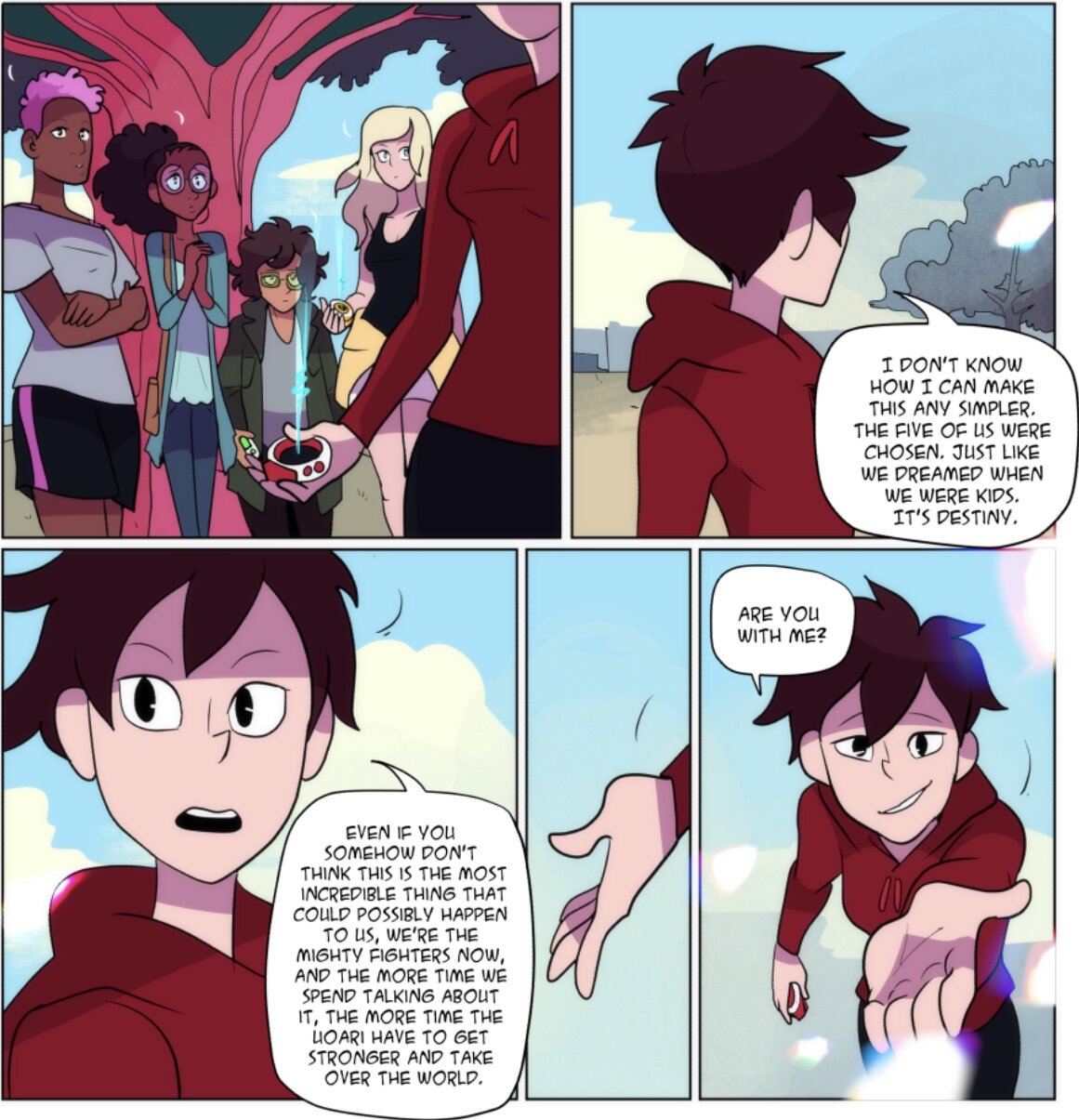Chroma Key by Brandon Dumas is the story of five teenagers with attitude that are chosen to save the world from an imminent alien invasion. Kim, April, Fuchsia, Parker, and Emily are all childhood friends with a shared love for the Super Fighting Mighty Fighters, a cheesy live-action television show featuring color-coded superheroes in spandex fighting rubber-suited monsters. After years of slowly drifting apart, the group finds themselves recruited by Luna, an alien refugee, who tasks them with defeating the bloodthirsty Uoari. The group must now defend the earth while reconciling their shattered friendship.
What is Kim’s role in the story as a standard anime protagonist?
Kim’s function in the group is completely evident from the start: she is the fearless leader. She’s the biggest Super Fighting Mighty Fighters fan ever, she’s keeps the team motivated and on-track and — most importantly — she’s wearing red. Chroma Key is explicitly based on Japanese tokusatsu shows, with their flashy practical effects, rubber and spandex suits, and giant robots. Naturally, these aren’t the only tropes that it borrows as Kim’s characterization as the leader is straight out of the tokusatsu handbook. While they have come in many forms, in recent years tokusatsu protagonists have merged with the almost-stereotypical type-B protagonist of shonen anime: young, overly eager boys or young men overflowing with potential. While “shonen” has become shorthand for “action/adventure” outside of Japan, it literally just stands for its target audience: young boys. Would they be able to identify with Kim who fits the expected personality type perfectly?
Credit: Brandon Dumas
A six-panel page.
First panel: A close-up of young Kim slightly opening a door and peeking though.
Second panel: A wider shot of Kim peeking out between two silhouetted adults arguing.
Third panel: An extreme close-up of Kim’s eye, wide open in surprise.
Fourth panel: A green glass bottle shatters as it was thrown against the door Kim had been peeking out from.
Fifth panel: A close-up of Kim’s hand as she locks the door from the inside.
Sixth panel: Kim is running down the stairs to the basement.
Credit: Brandon Dumas
A four-panel page.
First panel: Kim and April are hanging from a tether made from the their powers.
Second panel: A shot of Kim and April as they hang on to the tether. April is stunned while Kim is ecstatic.
Kim: Yes! I knew it!
April: Kim… How..?
Third panel: A close-up of Kim’s smiling face.
Kim: Power of friendship, April!
Fourth panel: A shot from behind as the energy tether continues to stretch out, a red and blue outstretched hand at the opposite end of it.
Kim: Power of fucking friendship!
“Why not?” would be the immediate response. Kim’s story follows a basic structure for protagonists in action stores. Firstly, she carries deep trauma from her childhood. Her parents seem to have fought a lot and been outright violent, and Kim’s escape from her reality was her favorite show. The unapologetic positivity of Super Fighting Mighty Fighters gave her comfort, and she could have even molded her eager and go-getter attitude from it. For the same reason, however, her empathy for others is lacking. She has difficulty understanding Parker (to the point of blatant disrespect in a later chapter), and she tends to think in overall simplistic terms. At the surface level, she has the most growth to do, which makes her the perfect character for the “intended audience” to learn from and grow with. On top of that, as a firm believer of the cheesiness of the show, she is the one that instinctually trusts and understands their new powers the most. They’ve allowed her to hold on as a kid during hard times, so she knows they’ll get her through this time.
Credit: Brandon Dumas
A five-panel page.
First panel: A shot of the team huddled close as Kim’s Chroma Key finishes a transmission from Luna.
Second panel: A shot of Kim from behind as she stares off to the distance.
Kim: I don’t know how I can make this any simpler. The five of us were chosen. Just like we dreamed when we were kids. It’s destiny.
Third panel: A close-up of Kim as she faces back to the rest of team.
Kim: Even if you somehow don’t think this is the most incredible thing that could happen to us, we’re the Mighty Fighters now, and the more time we spend talking about it, the more time the Uoari have to get stronger and take over the world.
Fourth panel: A close-up of Kim’s hand, reaching out.
Fifth panel: A shot of Kim, holding her hand out with a hopeful look on her face.
Kim: Are you with me?
As seen so far, narratively, Kim doesn’t really stray from the standard protagonist role. And therein lies the metanarrative point: she fulfills the role expertly without being a boy. As a whole, Chroma Key is a fan transformative creation intended to address the shortcomings of its source material, the iconic American adaptation of a Japanese tokusatsu show: Mighty Morphin Power Rangers. In its over 25-year-long history, Power Rangers has never featured a female Red Ranger protagonist. There have been two female red rangers: one was a villain, and the other stepped aside to let her brother lead the team. Kim comes as a direct response to the sexism that women cannot wear the red suit because the shonen audience wouldn’t identify with her (which would affect toy sales). Yet with her backstory and room for growth, belief in the power of friendship, and inspirational speeches, Kim proves that hyperactive, eager protagonists come in many forms.


